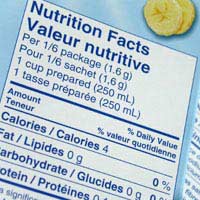Identifying Food Labels

With so much emphasis on sustainable, healthy living the conscientious individual may find themselves at pains to choose between products when shopping for food. Fortunately, there are regulations in place to make life easier for the environmentally minded and health conscious.
It is believed that organic, non-GM food is safe for the environment, relying on non-intensive farming methods that avoid the use of harmful pesticides and scientific practices.
Advocates of 'non-GM' eating often also claim that GM food is of a poorer quality than non-GM and may have adverse health side effects. Research into the health risks and environmental effects of GM food is ongoing and - so far - inconclusive: However, as organic farming methods are undoubtedly beneficial to the environment (burning less carbon than conventional methods whilst using no chemicals) and are always non-GM, it is a safe assumption that if you are shopping for a sustainable lifestyle you will be avoiding GM foods, whilst always buying organic.
What to Look For - Sustainable Labelling
Under EU laws passed in 2004 (The Traceability and Labelling of GMOs; EC No. 1830/2003 and the GM Food and Feed Regulation; EC No. 1829/2003) 'Genetically Modified' produce must be clearly labelled as such.The law does allow for the presence of 0.9% genetically modified material in food products that are not labelled 'GM'. This is because non-GM crops that come into contact with GM crops can contaminate them with small traces of GMOs (Genetically Modified Organisms).
The law has been criticised for being unclear: Companies are not obligated to label food as a 'GM product' or as a 'GM free' product and are only obligated to provide a small note stating that a specific ingredient is from a GM source (for example 'this product contains genetically modified […]').
Meat, poultry and eggs that have been reared on GM feed do not have to be labelled as GM at all. Therefore, if in doubt, it is always best to buy Organic.
Organic Labelling Law
Under the 'Organic Product Regulations 2004' and previous EU regulations passed in 1993, government-approved bodies, to ensure their authenticity, must strictly regulate food labelled 'organic'. Organic labelling must also stipulate which certification body the manufacturer adheres to. Each body has a number assigned to it, which will appear somewhere on the product label. They may also contain the logo of that certification company. For example, a product certified by the U.K's biggest certification body, 'the Soil Association', will contain their logo and the words: 'E.C Organic certification UK5'. Without such an endorsement you must assume that the product is not organic.Critics are unhappy with a clause in organic labelling law that states that a product certified as organic can contain up to 5% non-organic produce. One way to avoid this pitfall is to avoid buying readymade products that contain several ingredients: If you buy separate individual products that are marked as organic, such as unwrapped fruit and vegetables there will be no risk of it containing a rogue 5%, intensively farmed, GM element!


Re: Quiz: How Green is Your Life?
I appreciated this quiz because I discovered that with myself I can change something
Re: Quiz: How Green is Your Life?
Between 20-34 points You demonstrate a good environmental conscience – but there’s still room for improvement, so look at the…
Re: Quiz: How Green is Your Life?
I have got 25 points and I think it is okay, I feel good about it
Re: Quiz: How Green is Your Life?
I have 27 points and I think it's not bad but it could have been better.
Re: Quiz: How Green is Your Life?
I have 29 points, in my opinion it is quite a lot but on the other hand it could be better
Re: Quiz: How Green is Your Life?
I got 26 points so I think it's not bad but it could have been better. I will try to improve and live differently and better
Re: Quiz: How Green is Your Life?
Good check list and was happy to score high on most points. But I guess that is the case for most environmentally conscious folks…
Re: Fossil Fuel Debate
i have debate on consumption of fossil fuels. can you help me.
Re: Quiz: How Green is Your Life?
I am just wondering why tourism was left off your list? Surely unnecessary travel, needless environmental degradation, unabated…
Re: Fossil Fuel Debate
I am doing a debate about why fuel is good and this doesn't really help me.